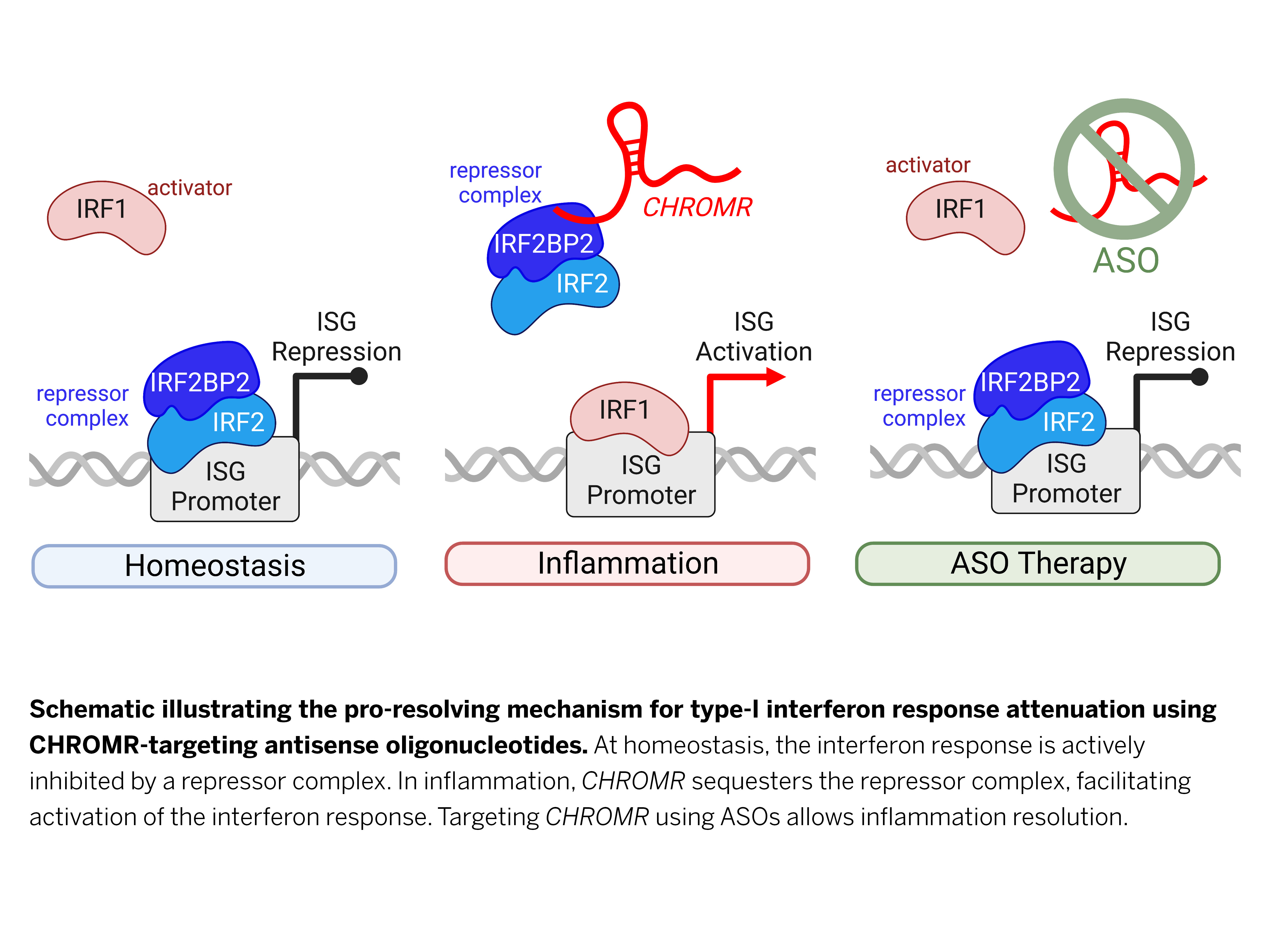ASOs Targeting CHROMR for the Treatment of Inflammatory Diseases
Innovative, efficacious, and patient-specific treatment for chronic inflammatory diseases mediated by hyperactive type-I interferon responses.

Technology
The inventors have identified and characterized a novel therapeutic target and corresponding targeting agent for the attenuation of hyperactive type-I interferon responses. In proof-of-concept studies (van Solingen et al., PNAS 2022), the inventors characterized the function of CHROMR, a primate-specific long non-coding RNA, to sequester the inflammatory repressor IRF2BP2 which leads to a hyperactive type-I interferon response. Additionally, they have engineered and optimized next-generation antisense oligonucleotides (ASOs) that inhibit CHROMR’s interaction with IRF2BP2 and abrogate the type-I interferon response in myeloid cells and human tissue explants (see schematic). The inventors are currently undertaking delivery, safety and anti-inflammatory efficacy studies in a bespoke humanized mouse model, and additional safety studies in non-human primates. These anti-CHROMR ASOs represent a novel approach to treating inflammation that promotes endogenous pathways of inflammation resolution rather than conventional blocking of pro-inflammatory pathways.
Background
Hyperactive type-I interferon responses underlie the etiology of many chronic and acute inflammatory diseases, such as autoimmune diseases and systemic inflammatory syndromes associated with infectious diseases. Systemic lupus erythematosus (SLE), for example, is an autoimmune disease characterized by an aberrant interferon-stimulated gene expression profile. Of note, SLE patients exhibit increased CHROMR levels in circulation as well as within isolated monocytes. Moreover, the aberrant genetic signature characteristic of this autoimmune disease correlates with those genes regulated by CHROMR. In addition to its association with systemic inflammatory syndromes, CHROMR is also upregulated and strongly correlated with a type-I interferon response expression profile in influenza A virus and SARS-CoV-2 infected individuals. These findings highlight the feasibility of targeting CHROMR for treatment of autoimmune diseases and systemic inflammatory syndromes associated with hyperactive type-I interferon response.
Applications
- Treatment of autoimmune diseases, including: systemic lupus erythematosus, common variable immunodeficiency, Aicardi-Goutières syndrome, psoriasis, monogenic interferonopathies, and others
- Treatment of systemic inflammatory syndromes, including: cytokine release syndromes common with infectious diseases and immunotherapies
Advantages
- Well-characterized, disease-implicated target: CHROMR is upregulated in inflammatory diseases and drives detrimental hyperactive type-I interferon responses
- Novel approach to inflammation treatment: Promoting inflammation resolution, rather than conventional blocking of pro-inflammatory pathways, holds promise for therapeutic intervention with minimal systemic immunosuppression
- Effective, FDA-approved therapeutic modality: Ten ASO therapeutics are currently approved
- Low toxicity: Specific ASO design prevents immune recognition while also reducing the risk of adverse off-target effects that are common to other approved interferon inhibitors
- Gymnotic cellular delivery: ASOs do not require ancillary delivery agents to cross the cell membrane
Intellectual Property
NYU has filed a PCT application covering composition and method of use
-
expand_more mode_edit Authors (1)Kathryn J. Moore, PhD
-
expand_more library_books References (1)
- Kathryn J. Moore, PhD , Long noncoding RNA CHROMR regulates antiviral immunity in humans
-
expand_more cloud_download Supporting documents (1)Product brochureASOs Targeting CHROMR for the Treatment of Inflammatory Diseases.pdf